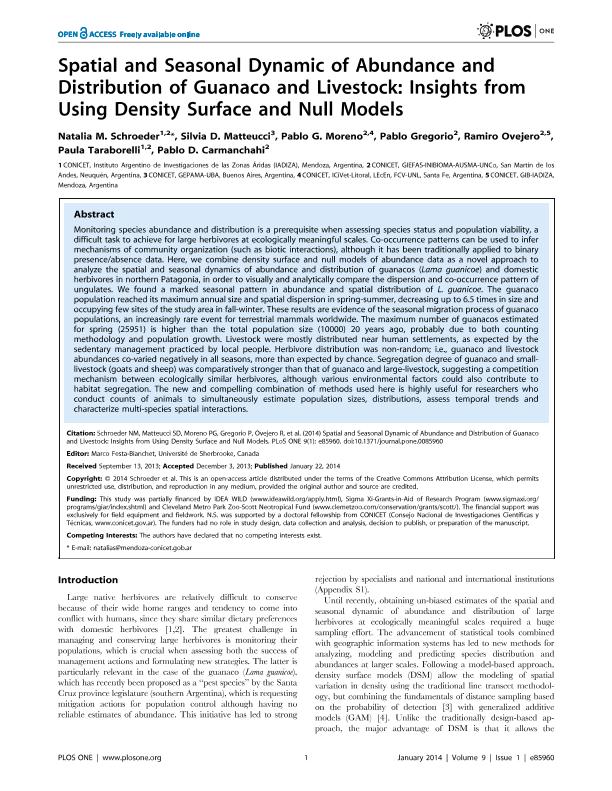Mostrar el registro sencillo del ítem
dc.contributor.author
Schroeder, Natalia

dc.contributor.author
Matteucci, Silvia Diana

dc.contributor.author
Moreno, Pablo Gastón

dc.contributor.author
Gregorio, Pablo Francisco

dc.contributor.author
Ovejero, Ramiro
dc.contributor.author
Taraborelli, Paula Andrea

dc.contributor.author
Carmanchahi, Pablo Daniel

dc.date.available
2016-12-14T16:56:16Z
dc.date.issued
2014-01
dc.identifier.citation
Schroeder, Natalia; Matteucci, Silvia Diana; Moreno, Pablo Gastón; Gregorio, Pablo Francisco; Ovejero, Ramiro; et al.; Spatial and seasonal dynamic of abundance and distribution of guanaco and livestock: insights from using density surface and null models; Public Library Of Science; Plos One; 9; 1; 1-2014; 1-12; E85930
dc.identifier.uri
http://hdl.handle.net/11336/9370
dc.description.abstract
Monitoring species abundance and distribution is a prerequisite when assessing species status and population viability, a difficult task to achieve for large herbivores at ecologically meaningful scales. Co-occurrence patterns can be used to infer mechanisms of community organization (such as biotic interactions), although it has been traditionally applied to binary presence/absence data. Here, we combine density surface and null models of abundance data as a novel approach to analyze the spatial and seasonal dynamics of abundance and distribution of guanacos (Lama guanicoe) and domestic herbivores in northern Patagonia, in order to visually and analytically compare the dispersion and co-occurrence pattern of ungulates. We found a marked seasonal pattern in abundance and spatial distribution of L. guanicoe. The guanaco population reached its maximum annual size and spatial dispersion in spring-summer, decreasing up to 6.5 times in size and occupying few sites of the study area in fall-winter. These results are evidence of the seasonal migration process of guanaco populations, an increasingly rare event for terrestrial mammals worldwide. The maximum number of guanacos estimated for spring (25951) is higher than the total population size (10000) 20 years ago, probably due to both counting methodology and population growth. Livestock were mostly distributed near human settlements, as expected by the sedentary management practiced by local people. Herbivore distribution was non-random; i.e., guanaco and livestock abundances co-varied negatively in all seasons, more than expected by chance. Segregation degree of guanaco and small- livestock (goats and sheep) was comparatively stronger than that of guanaco and large-livestock, suggesting a competition mechanism between ecologically similar herbivores, although various environmental factors could also contribute to habitat segregation. The new and compelling combination of methods used here is highly useful for researchers who conduct counts of animals to simultaneously estimate population sizes, distributions, assess temporal trends and characterize multi-species spatial interactions.
dc.format
application/pdf
dc.language.iso
eng
dc.publisher
Public Library Of Science

dc.rights
info:eu-repo/semantics/openAccess
dc.rights.uri
https://creativecommons.org/licenses/by/2.5/ar/
dc.title
Spatial and seasonal dynamic of abundance and distribution of guanaco and livestock: insights from using density surface and null models
dc.type
info:eu-repo/semantics/article
dc.type
info:ar-repo/semantics/artículo
dc.type
info:eu-repo/semantics/publishedVersion
dc.date.updated
2016-12-12T14:27:47Z
dc.identifier.eissn
1932-6203
dc.journal.volume
9
dc.journal.number
1
dc.journal.pagination
1-12; E85930
dc.journal.pais
Estados Unidos

dc.journal.ciudad
San Francisco
dc.description.fil
Fil: Schroeder, Natalia. Consejo Nacional de Investigaciones Científicas y Técnicas. Centro Científico Tecnológico Mendoza. Instituto Argentino de Investigaciones de Zonas Aridas; Argentina
dc.description.fil
Fil: Matteucci, Silvia Diana. Universidad de Buenos Aires. Facultad de Arquitectura y Urbanismo. Grupo de Ecologia del Paisaje y Medio Ambiente; Argentina. Consejo Nacional de Investigaciones Científicas y Técnicas; Argentina
dc.description.fil
Fil: Moreno, Pablo Gastón. Consejo Nacional de Investigaciones Científicas y Técnicas. Centro Científico Tecnológico Santa Fe. Instituto de Ciencias Veterinarias del Litoral; Argentina. Consejo Nacional de Investigaciones Científicas y Técnicas. Centro Científico Tecnológico Patagonia Norte. Instituto de Investigación en Biodiversidad y Medioambiente; Argentina
dc.description.fil
Fil: Gregorio, Pablo Francisco. Consejo Nacional de Investigaciones Científicas y Técnicas. Centro Científico Tecnológico Patagonia Norte. Instituto de Investigación en Biodiversidad y Medioambiente; Argentina
dc.description.fil
Fil: Ovejero, Ramiro. Consejo Nacional de Investigaciones Científicas y Técnicas. Centro Científico Tecnológico Patagonia Norte. Instituto de Investigación en Biodiversidad y Medioambiente; Argentina. Consejo Nacional de Investigaciones Científicas y Técnicas. Centro Científico Tecnológico Mendoza. Instituto Argentino de Investigaciones de Zonas Aridas; Argentina
dc.description.fil
Fil: Taraborelli, Paula Andrea. Consejo Nacional de Investigaciones Científicas y Técnicas. Centro Científico Tecnológico Mendoza. Instituto Argentino de Investigaciones de Zonas Aridas; Argentina. Consejo Nacional de Investigaciones Científicas y Técnicas. Centro Científico Tecnológico Patagonia Norte. Instituto de Investigación en Biodiversidad y Medioambiente; Argentina
dc.description.fil
Fil: Carmanchahi, Pablo Daniel. Consejo Nacional de Investigaciones Científicas y Técnicas. San Martín de los Andes, Neuquén; Argentina
dc.journal.title
Plos One

dc.relation.alternativeid
info:eu-repo/semantics/altIdentifier/url/http://dx.plos.org/10.1371/journal.pone.0085960.
dc.relation.alternativeid
info:eu-repo/semantics/altIdentifier/doi/http://dx.doi.org/10.1371/journal.pone.0085960
Archivos asociados
